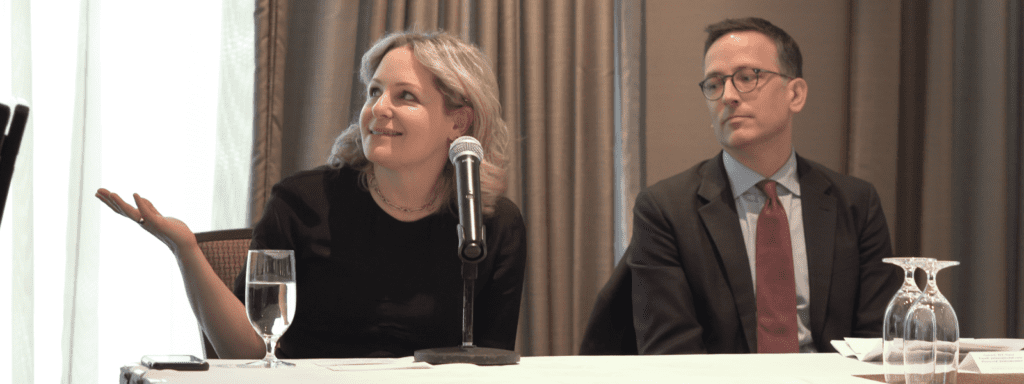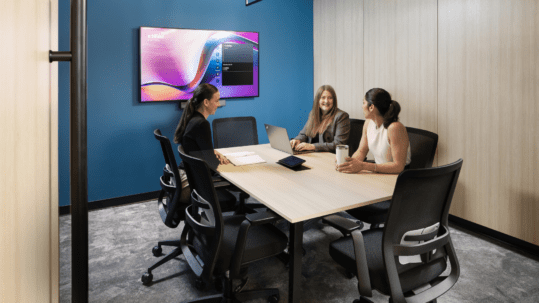Aura’s most recent edition of Tenant Talks on March 12 centered around the importance of navigating and adapting to contemporary developments in workplace design for the legal industry. With the topic at hand, the conversations and Q&As involving our panel of experts had a deep focus on the unique needs of law firms and the particular office-layout needs they require. Representatives from firms like Miller Thompson, Alexander Holburn, Harper Grey, and McCarthy Tétrault were on hand to lend their wide-ranging perspectives. Here are some of the topics raised during the talk, as well as the insights and debates that ensued.
VIDEO: Watch the full video of the event here.
Why renovate?
This was one of the easier questions to answer. Two distinct reasons held sway: first, increasing lease costs for commercial and office spaces meant a need to optimize any portion of an operations budget devoted to rent and associated needs. The other was a different kind of necessity: the need to expand past the office’s existing amount of space in order to accommodate business growth. In both cases, the necessary changes and end results of law office renovations would need to be accounted for.
Which design approach is best?
As the discussion revealed, there will always be competing views and resistance to whatever approach is taken. It typically depends on the needs of the lawyers at the firm, particularly whether they prefer a collaborative approach or value their privacy more.
Sven O. Milelli (McCarthy Tétrault) expressed the belief that an open-plan office is more collaborative and transparent, while confidentiality can still be not only preserved but enhanced thanks to adoption of digital tech that leaves no paper trail. David Pilley (Harper Grey) took the position that law offices could be more productive with more people around. And Mike Walker (Miller Thompson) stated that confidentiality was an “old canard we should just dispense with,” and that client confidentiality was no barrier to open-concept offices because members of the firm shared information anyways for the benefit of their clients.

Meanwhile, Janine Kroser (Alexander Holburn) observed that in her findings, open-concept offices, security and confidentiality notwithstanding, actually saw drops in collaboration and productivity. In the long run, sometimes it’s best to just go ahead with a plan and give both yourself and the firm as a whole enough time to get used to the transition.
What would you do differently in terms of office design?
Milelli’s perspective was that an important change at McCarthy Tétrault would be to consider the more functional needs of their work: for example, clear glass walls received some pushback from lawyers who were more inclined to prefer frosted glass for increased privacy. However, HR — the only department that actually had frosted glass walls — needed more privacy, so their space required more thought. In terms of real estate and litigation law, the amount of sheer paperwork may also require a transition in emphasis from small office to meeting room spaces. What his firm would do the same, however, would be to take advantage of the visibility afforded by glass partitions by letting younger members of the firm learn by watching senior lawyers work.
Pilley’s observations in comparing Harper Grey’s approach during their previous renovation 20 years ago to their most recent one were simple yet holistic: ask the entire staff for their input and feedback, not just the lawyers. That way, it helps the likelihood of creating and sustaining a positive working environment for all employees. Kroser had a tech-driven pragmatism in mind for Alexander Holburn: going digital and paperless would, among other things, drastically reduce the need for storage space. Walker’s view was that Miller Thompson over-provided common space such as their café and forum areas, which turned out to be larger than necessary compared to their insufficient client space.

What can you do to attract and retain younger talent?
Each presenter had their own approach and philosophy. The main points: younger lawyers want to work as a collaborative team (Pilley), were more technologically savvy (Milelli), had greater flexibility with work arrangements whether remotely or in-office (Kroser), and don’t value older “corner office” notions of status as much as they do a balanced work/home life (Walker).
How important are social spaces in the design of law offices?
According to both Alexander Holburn and Harper Grey, important enough to make up a large footprint of the office, even considering the costs of space. Lunchrooms in particular were highlighted by both firms as important focal points of collaborative meetings.
With a global crisis, how would you adapt your office space for remote work?
Considering the timing of this meeting in the midst of a drastically increased work-from-home necessity, the needs of remote work were addressed practically. The main concerns were IT and infrastructure, while mobile work and practice groups that don’t work in the office on certain days can relieve the pressure of decreasing space limits.
WATCH: Learn how these firms are implementing remote work policies in their firm.
What concerns should we have about office design in the legal profession?
To the tech-minded, Artificial Intelligence still seems like an unknown quantity, and there was an uncertainty as to whether it presents an opportunity or a threat. In a more concrete sense, the idea of the open-concept office may be causing some attrition, though McCarthy Tétrault observed that their hybrid space wasn’t an obstacle to recruiting partners and associates. Milelli also noted that concerns over noise in an open-concept office were mitigated by a hybrid approach due to different spaces having different acoustics. Miller Thompson’s Walker agreed, observing that quiet work zones could be achieved using anything from acoustically isolated meeting rooms to one-person quiet rooms to noise-cancelling headphones.

What kind of lessons can the legal profession learn from office designers?
Walker put it succinctly: “Don’t be afraid. Be bold. Hire good designers and trust their expertise the way we as lawyers expect our clients to trust our expertise.”
About Tenant Talks
Brought to you by Aura Office Environments, Tenant Talks is a lunch and learn speaker series featuring expert insights and best practices on office design, company culture and workplace strategy for businesses located in Vancouver. Stay tuned to our full video and don’t miss any details regarding future events by joining our subscription list.






